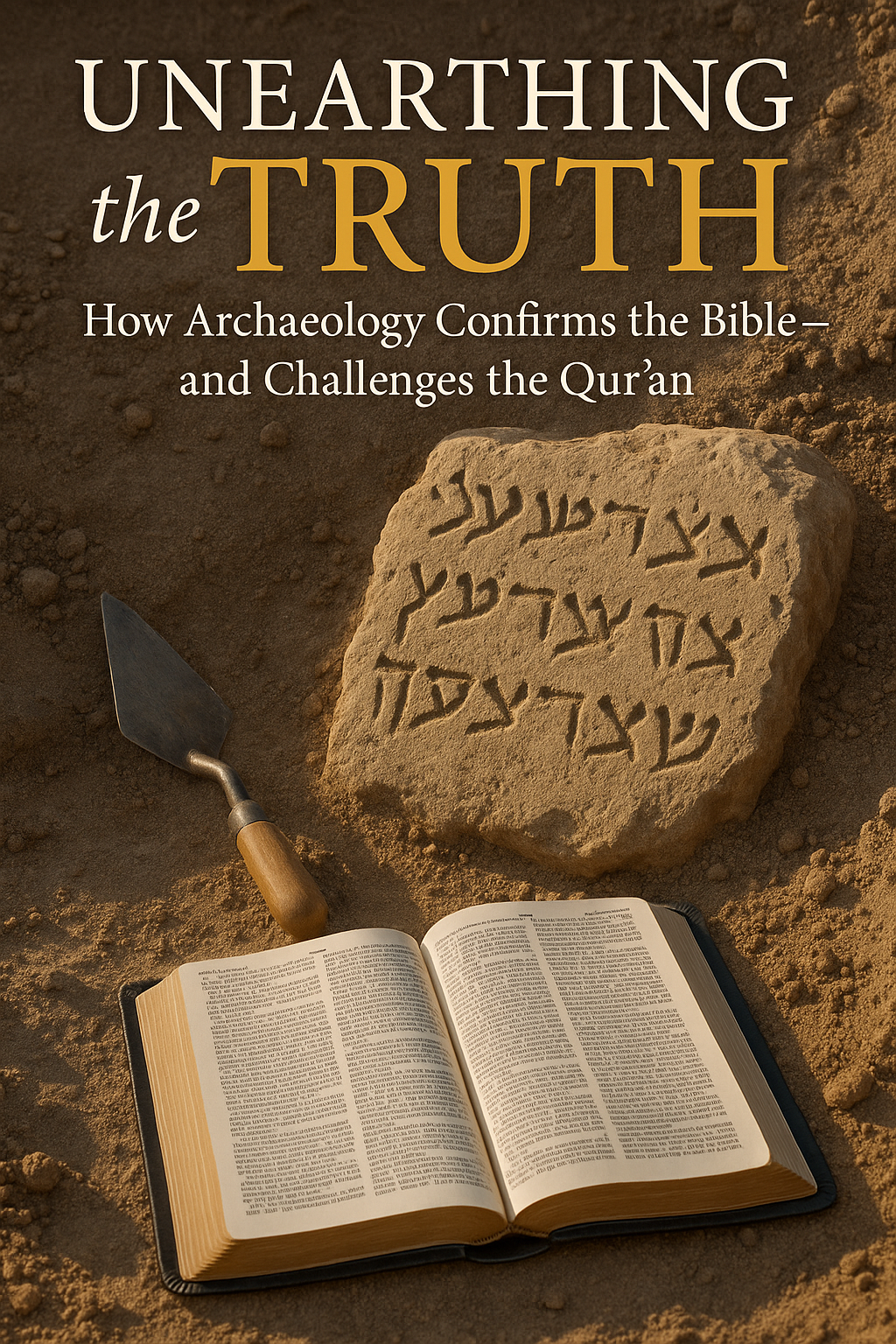

By Dr. Tim Orr
Archaeology plays a vital role when it comes to testing the historical claims of sacred texts. Unlike abstract philosophy or private spirituality, Christianity and Islam make concrete historical assertions about people, places, and events. That makes them testable. And that’s where the contrast becomes striking. While the Bible has been repeatedly confirmed by archaeological discoveries, the Qur'an's historical claims are often less clearly supported—or even contradiction—when subjected to the same scrutiny.
Let’s begin with the Bible. Its story is not one of vague moral tales floating in timeless myth but of real people encountering the living God in real places. Over the past century, archaeologists have uncovered mountains of evidence—literally—that confirm this historical grounding.
The Bible and the Stones Crying Out
Take Jericho, for instance—the city with the walls that famously “came a-tumblin’ down” in the book of Joshua. Kathleen Kenyon’s excavations in the 1950s raised questions about the timing of the collapse. Still, later studies—particularly by archaeologist Bryant Wood—suggest a violent destruction layer that aligns well with the biblical account (Wood, 1990). Similarly, the city of Hazor, mentioned in Joshua 11:10 as being burned by the Israelites, shows an apparent destruction by fire around 1200 BC. These aren’t just religious myths—they’re verifiable historical events.
Inscriptions provide even more tangible proof. The Tel Dan Stele, a 9th-century BC Aramaic inscription, refers to the “House of David.” This single stone shattered the long-standing academic skepticism about King David’s existence. Similarly, the Mesha Stele—or Moabite Stone—mentions the “House of Omri,” another biblical dynasty, confirming the historical accuracy of narratives in 1 and 2 Kings.
Then there are people—those elusive names in Scripture that skeptics once dismissed as invented. In Caesarea Maritima, archaeologists discovered a stone named Pontius Pilate, the very Roman governor who sentenced Jesus to death (Matthew 27). Near Jerusalem, an ossuary (a bone box) was found with the inscription “Joseph, son of Caiaphas”—believed to be the high priest who presided over Jesus’ trial (John 18:13). These aren’t just characters in a story; they’re part of history, confirmed through tangible archaeological discoveries like inscriptions and ossuaries that place these individuals in specific times and locations (Israel Museum, n.d.; John 18:13).
Even the structure of biblical covenants has found support in the ancient world. The suzerainty treaties discovered in Hittite and Mesopotamian archives reflect similar legal formulas, with preambles, stipulations, blessings, and curses, just like the format seen in Deuteronomy. This alignment with extra-biblical texts highlights how the Bible’s covenantal language fits seamlessly into its historical and cultural context. The suzerainty treaties from the second millennium BC mirror the legal framework of Deuteronomy, showing that Scripture’s covenantal format fits its cultural setting.
And then there are the Dead Sea Scrolls. These ancient manuscripts, dating from the third century BC to the first century AD, include nearly every book of the Old Testament. Remarkably, when compared with the Masoretic Text preserved a thousand years later, the differences are minimal. This testifies to the Bible’s historical veracity and the extraordinary care with which it was transmitted.
The Qur'an and the Case of the Missing Evidence
Now compare this with the archaeological evidence for the Qur'an. While the Bible benefits from open, ongoing, and rigorous excavation in Israel, Egypt, Jordan, and elsewhere, Islamic lands—particularly Saudi Arabia—actively suppress archaeological investigation that might challenge Islamic narratives.
Let’s talk about Mecca, the geographical heart of Islam. The Qur'an portrays it as a bustling religious and commercial hub dating back to Abraham and Ishmael (Surah 2:127). But here’s the problem: there’s virtually no archaeological or textual evidence for Mecca’s prominence before the rise of Islam. No inscriptions. No coins. No artifacts. No mentions in pre-Islamic literature. Patricia Crone’s seminal work Meccan Trade and the Rise of Islam (1987) argues that major trade routes in the 6th and 7th centuries didn’t even pass through Mecca. While her thesis has been influential, it has also faced critique from scholars who suggest that Mecca may have played a more modest regional role. Nevertheless, the lack of substantial archaeological evidence from Mecca remains a significant gap in the historical record.
Contrast this with cities like Jerusalem, Nineveh, or Babylon—cities mentioned in the Bible and repeatedly confirmed through excavations, inscriptions, and written histories. The Qur'anic narrative places Abraham in Mecca, building the Kaaba with Ishmael, but the biblical account situates him in Mesopotamia and Canaan (Genesis 11–25). There’s no archaeological or textual evidence that Abraham ever set foot in Arabia. Even the earliest Islamic biographies, such as Ibn Ishaq’s Sirat Rasul Allah, were written over a thousand years after Abraham’s life and are highly legendary.
Historical Problems and Anachronisms
Several historical blunders in the Qur'an also challenge its claim to divine origin. One example is the reference to Mary (the mother of Jesus) as the “sister of Aaron” (Surah 19:28). This appears to conflate her with Miriam, the sister of Moses and Aaron—a confusion of individuals separated by over a thousand years.
Another case is the Qur’an’s retelling of the story of Pharaoh’s death in the Red Sea. Surah 10:90–92 claims that Pharaoh's body was preserved after drowning—something not found in the biblical text and unsupported by Egyptology. Scholars have also pointed out that the Pharaoh of Moses is often portrayed in Islamic tradition with details that match rulers from later centuries.
Then there’s the story of the “Seven Sleepers of Ephesus,” a Christian legend from late antiquity. The Qur’an retells this fable in Surah 18, presenting it as divine revelation. But this tale was circulating widely in the Christian world, suggesting that the Qur’an draws from folkloric and religious sources available during Muhammad’s time, not from fresh historical insight.
A Culture of Suppression
To complicate matters, Saudi Arabia has systematically bulldozed early Islamic sites in Mecca and Medina—ostensibly for modernization, but critics suspect it’s also to avoid discoveries that might contradict Islamic tradition (Fitzgerald, 2014; Time Magazine, 2014). This makes archaeological verification nearly impossible. In contrast, biblical archaeology is conducted with international teams, peer-reviewed publications, and open access to sites and findings.
If the Islamic narrative were as archaeologically rich as the biblical one, we would expect the Qur'an’s claims to leave more tangible evidence behind. But instead, what we see is a landscape of suppression, silence, and anachronism.
Conclusion: Why It Matters
This isn’t just about winning an academic debate. For Christians, our faith rests on historical truth—on a real cross, in a real city, under a Roman governor. As Luke writes at the beginning of his Gospel, these things were “handed down to us by those who from the first were eyewitnesses” (Luke 1:2). Archaeology repeatedly affirms that claim.
In contrast, the Qur'an’s historical claims often unravel under scrutiny. That should raise honest questions for Muslims—and open a door for conversations about the credibility of Jesus, the reliability of Scripture, and the hope of the gospel rooted in real history.
References
Crone, P. (1987). Meccan Trade and the Rise of Islam. Princeton University Press.
Kenyon, K. M. (1957). Digging Up Jericho. London: Ernest Benn.
Wood, B. G. (1990). Did the Israelites Conquer Jericho? A New Look at the Archaeological Evidence. Biblical Archaeology Review, 16(2), 44–58.
Dead Sea Scrolls. (n.d.). The Israel Museum, Jerusalem.
Tel Dan Stele. (n.d.). Israel Antiquities Authority.
Pontius Pilate Inscription. (n.d.). Israel Museum.
Mesha Stele. (n.d.). Louvre Museum.
Who is Dr. Tim Orr?
Tim serves full-time with Crescent Project as the assistant director of the internship program and area coordinator, where he is also deeply involved in outreach across the UK. A scholar of Islam, Evangelical minister, conference speaker, and interfaith consultant, Tim brings over 30 years of experience in cross-cultural ministry. He holds six academic degrees, including a Doctor of Ministry from Liberty University and a Master’s in Islamic Studies from the Islamic College in London.
In addition to his ministry work, Tim is a research associate with the Congregations and Polarization Project at the Center for the Study of Religion and American Culture at Indiana University Indianapolis. His research interests include Islamic antisemitism, American Evangelicalism, and Islamic feminism. He has spoken at leading universities and mosques throughout the UK—including Oxford University, Imperial College London, and the University of Tehran—and has published widely in peer-reviewed Islamic academic journals. Tim is also the author of four books.
